Chitosan-Based Dressing Materials for Burn Wound Healing
Abstract
1. Burn Wound and Healing Materials
2. Chitosan and Its Derivatives for Burn Wound Dressings
3. Forms of Chitosan-Based Burn Wound Dressings
4. Functional Chitosan-Based Wound Dressings for Burn Wound Treatment
4.1. Antimicrobial and Antioxidant Chitosan-Based Burn Wound Dressings
4.2. Chitosan-Based Burn Wound Dressings for Tissue Engineering
5. Outlook and Summary
5.1. Outlook
5.2. Summary
Author Contributions
Funding
Institutional Review Board Statement
Data Availability Statement
Conflicts of Interest
References
- Ren, H.; Zhang, Z.; Lu, K.L.; Shen, Y.Y.; He, C.L.; Chen, X.S. Injectable Chitosan Hydrogels Loaded with Antioxidant Agent as First-Aid Dressings for Second-Degree Burn Wounds. Sci. China-Technol. Sci. 2024, 67, 891–901. [Google Scholar] [CrossRef]
- Surowiecka, A.; Struzyna, J.; Winiarska, A.; Korzeniowski, T. Hydrogels in Burn Wound Management-a Review. Gels 2022, 8, 122. [Google Scholar] [CrossRef]
- Cook, K.A.; Martinez-Lozano, E.; Sheridan, R.; Rodriguez, E.K.; Nazarian, A.; Grinstaff, M.W. Hydrogels for the Management of Second-Degree Burns: Currently Available Options and Future Promise. Burn. Trauma 2022, 10, tkac047. [Google Scholar] [CrossRef]
- Yu, Q.; Sun, H.; Yue, Z.; Yu, C.; Jiang, L.; Dong, X.; Yao, M.; Shi, M.; Liang, L.; Wan, Y.; et al. Zwitterionic Polysaccharide-Based Hydrogel Dressing as a Stem Cell Carrier to Accelerate Burn Wound Healing. Adv. Health. Mater. 2022, 12, 2202309. [Google Scholar] [CrossRef]
- Xu, H.L.; Chen, P.P.; ZhuGe, D.L.; Zhu, Q.Y.; Jin, B.H.; Shen, B.X.; Xiao, J.; Zhao, Y.Z. Liposomes with Silk Fibroin Hydrogel Core to Stabilize Bfgf and Promote the Wound Healing of Mice with Deep Second-Degree Scald. Adv. Health. Mater. 2017, 6, 1700344. [Google Scholar] [CrossRef]
- Widgerow, A.D.; King, K.; Tocco-Tussardi, I.; Banyard, D.A.; Chiang, R.; Awad, A.; Afzel, H.; Bhatnager, S.; Melkumyan, S.; Wirth, G.; et al. The Burn Wound Exudate-an under-Utilized Resource. Burns 2015, 41, 11–17. [Google Scholar] [CrossRef]
- Dewi, I.S.; Handayani, E.; Masithoh, R.F.; Kamal, S.; Nugroho, S.H.P.; Wahyuningtyas, E.S.; Amin, M.K.; Priyo; Priyanto, S. Pain Management with Virtual Reality in Burn Patients: A Literature Review. Br. J. Community Nurs. 2024, 29, S22–S28. [Google Scholar] [CrossRef]
- Craig, C.K.; Williams, J.W.; Carter, J.E.; Holmes, J.H. Bismuth/Petroleum Gauze Plus High Density Polyethylene vs. Bismuth/Petroleum Gauze: A Comparison of Donor Site Healing and Patient Comfort. Burns 2022, 48, 1917–1921. [Google Scholar] [CrossRef]
- Sanchez, M.F.; Guzman, M.L.; Flores-Martín, J.; Del Puerto, M.C.; Laino, C.; Soria, E.A.; Donadio, A.C.; Genti-Raimondi, S.; Olivera, M.E. Ionic Complexation Improves Wound Healing in Deep Second-Degree Burns and Reduces in-Vitro Ciprofloxacin Cytotoxicity in Fibroblasts. Sci. Rep. 2022, 12, 16035. [Google Scholar] [CrossRef]
- Ju, H.W.; Lee, O.J.; Lee, J.M.; Moon, B.M.; Park, H.J.; Park, Y.R.; Lee, M.C.; Kim, S.H.; Chao, J.R.; Ki, C.S.; et al. Wound Healing Effect of Electrospun Silk Fibroin Nanomatrix in Burn-Model. Int. J. Biol. Macromol. 2016, 85, 29–39. [Google Scholar] [CrossRef]
- Song, J.H.; Gu, J.T.; Dang, G.P.; Wan, M.C.; Bai, Y.K.; Bai, Q.; Jiao, K.; Niu, L.N. DNA-Collagen Dressing for Promoting Scarless Healing in Early Burn Wound Management. Adv. Compos. Hybrid Mater. 2025, 8, 212. [Google Scholar] [CrossRef]
- Shah, J.; Patel, D.; Rananavare, D.; Hudson, D.; Tran, M.; Schloss, R.; Langrana, N.; Berthiaume, F.; Kumar, S. Recent Advancements in Chitosan-Based Biomaterials for Wound Healing. J. Funct. Biomater. 2025, 16, 45. [Google Scholar] [CrossRef] [PubMed]
- Ma, L.; Zhu, Y.; Wang, L.; Yang, Z.; Li, X.; Chen, M.; Yuan, M.; Li, W.; Ma, X.; Xiong, H.; et al. Multi-Form Antibacterial Dressings Based on a Deep Eutectic Supramolecular Polymer Promote Healing of Burn Wounds through a Weakly Acidic Microenvironment. Chem. Eng. J. 2024, 494, 153153. [Google Scholar] [CrossRef]
- Zhai, G.T.; Wang, Y.; Han, P.; Xiao, T.; You, J.; Guo, C.L.; Wu, X.C. Drug Loaded Marine Polysaccharides-Based Hydrogel Dressings for Treating Skin Burns. Int. J. Biol. Macromol. 2024, 281, 135779. [Google Scholar] [CrossRef]
- Bano, I.; Arshad, M.; Yasin, T.; Ghauri, M.A. Preparation, Characterization and Evaluation of Glycerol Plasticized Chitosan/Pva Blends for Burn Wounds. Int. J. Biol. Macromol. 2019, 124, 155–162. [Google Scholar] [CrossRef]
- Cherng, J.H.; Lin, C.A.J.; Liu, C.C.; Yeh, J.Z.; Fan, G.Y.; Tsai, H.D.; Chung, C.F.; Hsu, S.D. Hemostasis and Anti-Inflammatory Abilities of Aunps-Coated Chitosan Dressing for Burn Wounds. J. Pers. Med. 2022, 12, 1089. [Google Scholar] [CrossRef]
- Wang, W.Q.; Meng, Q.Y.; Li, Q.; Liu, J.B.; Zhou, M.; Jin, Z.; Zhao, K. Chitosan Derivatives and Their Application in Biomedicine. Int. J. Mol. Sci. 2020, 21, 487. [Google Scholar] [CrossRef]
- Alam Shah, M.K.; Nawaz, A.; Latif, M.S.; Ullah, W.; Ullah, A.; Khan, A.A.; Malik, A.; Kumarasamy, V.; Subramaniyan, V.; Azad, A.K. Chitosan-Based Mupirocin and Alkanna Tinctoria Extract Nanoparticles for the Management of Burn Wound: In Vitro and in Vivo Characterization. Nanotechnol. Rev. 2024, 13, 20240065. [Google Scholar] [CrossRef]
- Huq, T.; Khan, A.; Brown, D.; Dhayagude, N.; He, Z.; Ni, Y. Sources, Production and Commercial Applications of Fungal Chitosan: A Review. J. Bioresour. Bioprod. 2022, 7, 85–98. [Google Scholar] [CrossRef]
- Ayers, L.C.; Johnson, R.M.; Tolfree, A.R.; Al Kharji, N.M.; Senarathna, M.C.; Arora, N.; Smaldone, R.A. Effects of the Chitosan Source on the Properties of 3d Printed Polymer Composites. ACS Appl. Polym. Mater. 2025, 7, 2644–2651. [Google Scholar] [CrossRef]
- Hsu, S.H.; Whu, S.W.; Tsai, C.L.; Wu, Y.H.; Chen, H.W.; Hsieh, K.H. Chitosan as Scaffold Materials: Effects of Molecular Weight and Degree of Deacetylation. J. Polym. Res. 2004, 11, 141–147. [Google Scholar] [CrossRef]
- Zhang, L.H.; Gao, C.C.; Wang, Z.J.; Xie, F.W.; Chen, Y.; Meng, L.H.; Tang, X.Z. Structure and Properties of Thermomechanically Processed Chitosan-Based Biomimetic Composite Materials: Effect of Chitosan Molecular Weight. ACS Sustain. Chem. Eng. 2023, 11, 708–717. [Google Scholar] [CrossRef]
- Tien, N.D.; Geng, T.X.; Heyward, C.A.; Reseland, J.E.; Lyngstadaas, S.P.; Blaker, J.J.; Haugen, H.J. Solution Blow Spinning of Highly Deacetylated Chitosan Nanofiber Scaffolds for Dermal Wound Healing. Biomater. Adv. 2022, 137, 212871. [Google Scholar] [CrossRef] [PubMed]
- Heidari, F.; Razavi, M.; Bahrololoom, M.E.; Tahriri, M.; Tayebi, L. Investigation of the Mechanical Properties and Degradability of a Modified Chitosan-Based Scaffold. Mater. Chem. Phys. 2018, 204, 187–194. [Google Scholar] [CrossRef]
- Xu, Y.; Li, L.; Cao, S.; Zhu, B.; Yao, Z. An Updated Comprehensive Review of Advances on Structural Features, Catalytic Mechanisms, Modification Methods and Applications of Chitosanases. Process. Biochem. 2022, 118, 263–273. [Google Scholar] [CrossRef]
- Zhu, J.Y.; Ma, Z.Y.; Xiao, M.; Wang, L.S.; Jiang, X.K. Molecular Dynamics Simulations of the Interaction between Chitosan and Bacterial Membranes. Prog. Biochem. Biophys 2023, 50, 1995–2005. [Google Scholar]
- Eulálio, H.Y.C.; Vieira, M.; Fideles, T.B.; Tomás, H.; Silva, S.M.L.; Peniche, C.A.; Fook, M.V.L. Physicochemical Properties and Cell Viability of Shrimp Chitosan Films as Affected by Film Casting Solvents. I-Potential Use as Wound Dressing. Materials 2020, 13, 5005. [Google Scholar] [CrossRef]
- Ji, M.C.; Li, F.Y.; Li, J.Y.; Li, J.F.; Wang, X.J.; Zhang, C.W.; Peng, S.X.; Man, J. Physical, Antibacterial, Blood Coagulation, and Healing Promotion Evaluations of Chitosan Derivative-Based Composite Films. Int. J. Biol. Macromol. 2024, 278, 134714. [Google Scholar] [CrossRef]
- Mottaghitalab, F.; Khodadadi Yazdi, M.; Reza Saeb, M.; Bączek, T.; Farokhi, M. Green and Sustainable Hydrogels Based on Quaternized Chitosan to Enhance Wound Healing. Chem. Eng. J. 2024, 492, 152288. [Google Scholar] [CrossRef]
- Chiu, P.-H.; Wu, Z.-Y.; Hsu, C.-C.; Chang, Y.-C.; Huang, C.-M.; Hu, C.-T.; Lin, C.-M.; Chang, S.C.; Hsieh, H.-J.; Dai, C.-A. Enhancement of Antibacterial Activity in Electrospun Fibrous Membranes Based on Quaternized Chitosan with Caffeic Acid and Berberine Chloride for Wound Dressing Applications. RSC Adv. 2024, 14, 34756–34768. [Google Scholar] [CrossRef]
- Panda, P.K.; Dash, P.; Chang, Y.-H.; Yang, J.-M. Improvement of Chitosan Water Solubility by Fumaric Acid Modification. Mater. Lett. 2022, 316, 132046. [Google Scholar] [CrossRef]
- Zhou, C.; Jiang, T.; Liu, S.J.; He, Y.J.; Yang, G.C.; Nie, J.Q.; Wang, F.Y.; Yang, X.F.; Chen, Z.B.; Lu, C.F. Agnps Loaded Adenine-Modified Chitosan Composite Poss-Peg Hybrid Hydrogel with Enhanced Antibacterial and Cell Proliferation Properties for Promotion of Infected Wound Healing. Int. J. Biol. Macromol. 2024, 267, 131575. [Google Scholar] [CrossRef] [PubMed]
- He, X.R.; Zhang, Z.P.; Xuan, X.; Tan, T.Y.; Sun, J.X.; Wang, B.; Tian, Y.; Chen, H. Structure and Properties of Chitosan Plasticized with Hydrophobic Short-Chain Fatty Acid Cosolvent. Int. J. Biol. Macromol. 2025, 300, 140250. [Google Scholar] [CrossRef]
- Chalitangkoon, J.; Ronte, A.; Monvisade, P. Carboxyethylation of Chitosan-Based Polymeric Dyes for Potential Ph-Sensing Applications. J. Taiwan Inst. Chem. Eng. 2023, 149, 105001. [Google Scholar] [CrossRef]
- Xu, R.B.; Aotegen, B.; Zhong, Z.M. Synthesis, Characterization and Biological Activity of C6-Schiff Bases Derivatives of Chitosan. Int. J. Biol. Macromol. 2017, 105, 1563–1571. [Google Scholar] [CrossRef]
- Pang, G.; Yi, M.; Yin, X.; Wu, W.; Xu, S. Immobilization of Chitosan on Polyether Ether Ketone Surface Modified with Acrylic Acid by Uv-Induced Graft Polymerization. Iran. Polym. J. 2022, 31, 1399–1407. [Google Scholar] [CrossRef]
- Huang, Y.; Zhang, G.; Liu, J.; Wang, Q.; Shen, S.; Liu, D.; Hong, Y.; Sun, S.; Wyman, I. Overview on Modified Membranes by Different Polysaccharides and Their Derivatives: Preparation and Performances. J. Environ. Chem. Eng. 2024, 12, 111980. [Google Scholar] [CrossRef]
- Tan, L.; Sun, B.B.; Luo, W.; Liu, S.T.; Qiu, B.W.; Zhang, H.; Liang, M.; Xia, S.; Zou, H.W. Enhanced Mechanical Property and Water Solubility of Polyvinyl Alcohol Film Via Constructing Hydrogen-Bond Network by Adding Carboxymethyl Chitosan. J. Macromol. Sci. Part A 2024, 61, 31–39. [Google Scholar] [CrossRef]
- Yang, C.; Chen, Y.; Huang, H.; Fan, S.; Yang, C.; Wang, L.; Li, W.; Niu, W.; Liao, J. Ros-Eliminating Carboxymethyl Chitosan Hydrogel to Enhance Burn Wound-Healing Efficacy. Front. Pharmacol. 2021, 12, 679580. [Google Scholar] [CrossRef]
- Huang, Y.; Mu, L.; Zhao, X.; Han, Y.; Guo, B. Bacterial Growth-Induced Tobramycin Smart Release Self-Healing Hydrogel for Pseudomonas Aeruginosa-Infected Burn Wound Healing. ACS Nano 2022, 16, 13022–13036. [Google Scholar] [CrossRef]
- Rúnarsson, Ö.; Holappa, J.; Jónsdóttir, S.; Steinsson, H.; Másson, M. N-Selective ‘One Pot’ Synthesis of Highly N-Substituted Trimethyl Chitosan (Tmc). Carbohydr. Polym. 2008, 74, 740–744. [Google Scholar] [CrossRef]
- Cai, J.P.; Dang, Q.F.; Liu, C.S.; Fan, B.; Yan, J.Q.; Xu, Y.Y.; Li, J.J. Preparation and Characterization of N-Benzoyl-O-Acetyl-Chitosan. Int. J. Biol. Macromol. 2015, 77, 52–58. [Google Scholar] [CrossRef] [PubMed]
- Palacio, D.A.; Urbano, B.F.; Palencia, M.; Rivas, B.L. Preparation of Alkylated Chitosan-Based Polyelectrolyte Hydrogels: The Effect of Monomer Charge on Polymerization. Eur. Polym. J. 2019, 118, 551–560. [Google Scholar] [CrossRef]
- Zhang, Y.; Guan, J.; Wu, J.; Ding, S.; Yang, J.; Zhang, J.; Dong, A.; Deng, L. N-Alkylated Chitosan/Graphene Oxide Porous Sponge for Rapid and Effective Hemostasis in Emergency Situations. Carbohydr. Polym. 2019, 219, 405–413. [Google Scholar] [CrossRef]
- Chen, Z.; Yao, X.; Liu, L.; Guan, J.; Liu, M.; Li, Z.; Yang, J.; Huang, S.; Wu, J.; Tian, F.; et al. Blood Coagulation Evaluation of N -Alkylated Chitosan. Carbohydr. Polym. 2017, 173, 259–268. [Google Scholar] [CrossRef]
- Zarandona, I.; Puertas, A.I.; Dueñas, M.T.; Guerrero, P.; de la Caba, K. Assessment of Active Chitosan Films Incorporated with Gallic Acid. Food Hydrocoll. 2020, 101, 105486. [Google Scholar] [CrossRef]
- Liu, L.H.; Zheng, J.; Li, S.H.; Deng, Y.Y.; Zhao, S.F.; Tao, N.; Chen, W.S.; Li, J.H.; Liu, Y.N. Nitric Oxide-Releasing Multifunctional Catechol-Modified Chitosan/Oxidized Dextran Hydrogel with Antibacterial, Antioxidant, and Pro-Angiogenic Properties for Mrsa-Infected Diabetic Wound Healing. Int. J. Biol. Macromol. 2024, 263, 130225. [Google Scholar] [CrossRef]
- Sukumaran, S.A.; Kalimuthu, B.; Selvamurugan, N.; Mani, P. Wound Dressings Based on Chitosan/Gelatin/Mgo Composite Films. Int. J. Polym. Mater. 2022, 71, 1252–1261. [Google Scholar] [CrossRef]
- Kaczmarek, B.; Mazur, O.; Milek, O.; Michalska-Sionkowska, M.; Das, A.; Jaiswal, A.; Vishnu, J.; Tiwari, K.; Sionkowska, A.; Osyczka, A.M.; et al. Design, Characterization and in Vitro Evaluation of Thin Films Enriched by Tannic Acid Complexed by Fe(Iii) Ions. Prog. Biomater. 2020, 9, 249–257. [Google Scholar] [CrossRef]
- Jayakumar, R.; Prabaharan, M.; Kumar, P.T.S.; Nair, S.V.; Tamura, H. Biomaterials Based on Chitin and Chitosan in Wound Dressing Applications. Biotechnol. Adv. 2011, 29, 322–337. [Google Scholar] [CrossRef]
- Jiang, Z.W.; Wang, Y.T.; Li, L.L.; Hu, H.W.; Wang, S.; Zou, M.Y.; Liu, W.S.; Han, B.Q. Preparation, Characterization, and Biological Evaluation of Transparent Thin Carboxymethyl-Chitosan/Oxidized Carboxymethyl Cellulose Films as New Wound Dressings. Macromol. Biosci. 2022, 22, 2100308. [Google Scholar] [CrossRef] [PubMed]
- Bianchi, E.; Ruggeri, M.; Vigani, B.; Fila, C.T.; Cornaglia, A.I.; Boselli, C.; Viseras, C.; Rossi, S.; Sandri, G. Gas Foamed Scaffolds as Smart 3d Structures in Skin Tissue Engineering. J. Drug Delivery Sci. Technol. 2024, 95, 105541. [Google Scholar] [CrossRef]
- El-Feky, G.S.; Sharaf, S.S.; El Shafei, A.; Hegazy, A.A. Using Chitosan Nanoparticles as Drug Carriers for the Development of a Silver Sulfadiazine Wound Dressing. Carbohydr. Polym. 2017, 158, 11–19. [Google Scholar] [CrossRef]
- Stoica, A.E.; Chircov, C.; Grumezescu, A.M. Hydrogel Dressings for the Treatment of Burn Wounds: An up-to-Date Overview. Materials 2020, 13, 2853. [Google Scholar] [CrossRef]
- Zhang, S.W.; Yang, W.; Gong, W.J.; Lu, Y.H.; Yu, D.G.; Liu, P. Recent Progress of Electrospun Nanofibers as Burning Dressings. RSC Adv. 2024, 14, 14374–14391. [Google Scholar] [CrossRef]
- Sharifi, A.; Mashjoor, S.; Makhmalzadeh, B.S.; Khorsandi, L.; Shushizadeh, M.R. Baicalin-Loaded Proline and Hydroxy Proline Functionalized Chitosan Derivative Nanofiber Composite as Burning Wound Dressings. Appl. Mater. Today 2024, 41, 102519. [Google Scholar] [CrossRef]
- Nematollahi, S.; Maghsoudian, S.; Motasadizadeh, H.; Nouri, Z.; Azad, K.; Fatahi, Y.; Samadi, N.; Mahmoudieh, M.; Shaabani, A.; Dinarvand, R. Polyhexamethylene Biguanidine Coated Silver Nanoparticles Embedded into Chitosan Thiourea/Pva Nanofibers as Wound Healing Mats: In Vitro and in Vivo Studies. Carbohydr. Polym. 2025, 347, 122704. [Google Scholar] [CrossRef]
- Wang, J.; Duan, X.X.; Zhong, D.H.; Zhang, M.Q.; Li, J.Y.; Hu, Z.J.; Han, F. Pharmaceutical Applications of Chitosan in Skin Regeneration: A Review. Int. J. Biol. Macromol. 2024, 261, 129064. [Google Scholar] [CrossRef]
- Zahra, D.; Shokat, Z.; Ahmad, A.; Javaid, A.; Khurshid, M.; Ashfaq, U.A.; Nashwan, A.J. Exploring the Recent Developments of Alginate Silk Fibroin Material for Hydrogel Wound Dressing: A Review. Int. J. Biol. Macromol. 2023, 248, 125989. [Google Scholar] [CrossRef]
- Huang, W.J.; Wang, Y.X.; Huang, Z.Q.; Wang, X.L.; Chen, L.Y.; Zhang, Y.; Zhang, L.N. On-Demand Dissolvable Self-Healing Hydrogel Based on Carboxymethyl Chitosan and Cellulose Nanocrystal for Deep Partial Thickness Burn Wound Healing. ACS Appl. Mater. 2018, 10, 41076–41088. [Google Scholar] [CrossRef]
- Goh, M.; Du, M.; Peng, W.R.; Saw, P.E.; Chen, Z.Y. Advancing Burn Wound Treatment: Exploring Hydrogel as a Transdermal Drug Delivery System. J. Drug Deliv. 2024, 31, 2300945. [Google Scholar] [CrossRef] [PubMed]
- Ding, Q.T.; Liu, X.L.; Liu, X.X.; Chai, G.D.; Wang, N.; Ma, S.; Zhang, L.F.; Zhang, S.; Yang, J.L.; Wang, Y.J.; et al. Polyvinyl Alcohol/Carboxymethyl Chitosan-Based Hydrogels Loaded with Taxifolin Liposomes Promote Diabetic Wound Healing by Inhibiting Inflammation and Regulating Autophagy. Int. J. Biol. Macromol. 2024, 263, 130226. [Google Scholar] [CrossRef] [PubMed]
- Tian, B.; Hua, S.; Tian, Y.; Liu, J. Chemical and Physical Chitosan Hydrogels as Prospective Carriers for Drug Delivery: A Review. J. Mater. Chem. B 2020, 8, 10050–10064. [Google Scholar] [CrossRef] [PubMed]
- Iqbal, Y.; Ahmed, I.; Irfan, M.F.; Chatha, S.A.S.; Zubair, M.; Ullah, A. Recent Advances in Chitosan-Based Materials; the Synthesis, Modifications and Biomedical Applications. Carbohydr. Polym. 2023, 321, 121318. [Google Scholar] [CrossRef]
- Lu, J.W.; Chen, Y.; Ding, M.; Fan, X.K.; Hu, J.W.; Chen, Y.H.; Li, J.; Li, Z.H.; Liu, W.Y. A 4arm-Peg Macromolecule Crosslinked Chitosan Hydrogels as Antibacterial Wound Dressing. Carbohydr. Polym. 2022, 277, 118871. [Google Scholar] [CrossRef]
- Tsai, C.C.; Young, T.H.; Chen, G.S.; Cheng, N.C. Developing a Glyoxal-Crosslinked Chitosan/Gelatin Hydrogel for Sustained Release of Human Platelet Lysate to Promote Tissue Regeneration. Int. J. Mol. Sci. 2021, 22, 6451. [Google Scholar] [CrossRef]
- Keshavarz, H.; Khavandi, A.; Alamolhoda, S.; Naimi-Jamal, M.R. Ph-Sensitive Magnetite Mesoporous Silica Nanocomposites for Controlled Drug Delivery and Hyperthermia. RSC Adv. 2020, 10, 39008–39016. [Google Scholar] [CrossRef]
- Thirupathi, K.; Raorane, C.J.; Ramkumar, V.; Ulagesan, S.; Santhamoorthy, M.; Raj, V.; Krishnakumar, G.S.; Phan, T.T.V.; Kim, S.C. Update on Chitosan-Based Hydrogels: Preparation, Characterization, and Its Antimicrobial and Antibiofilm Applications. Gels 2023, 9, 35. [Google Scholar] [CrossRef]
- Teoh, J.H.; Mozhi, A.; Sunil, V.; Tay, S.M.; Fuh, J.; Wang, C.-H. 3D Printing Personalized, Photocrosslinkable Hydrogel Wound Dressings for the Treatment of Thermal Burns. Adv. Funct. Mater. 2021, 31, 2105932. [Google Scholar]
- Salagierski, S.; Dziadek, M.; Zagrajczuk, B.; Domalik-Pyzik, P.; Serafim, A.; Stancu, I.-C.; Cholewa-Kowalska, K. When Dynamic Covalent Chemistry Meets Bioactive Glasses—Novel Multi-Level Crosslinked, Injectable, Self-Healing Chitosan-Based Hydrogels. Sustain. Mater. Technol. 2024, 39, e00850. [Google Scholar] [CrossRef]
- Pita-López, M.L.; Fletes-Vargas, G.; Espinosa-Andrews, H.; Rodríguez-Rodríguez, R. Physically Cross-Linked Chitosan-Based Hydrogels for Tissue Engineering Applications: A State-of-the-Art Review. Eur. Polym. J. 2021, 145, 110176. [Google Scholar] [CrossRef]
- Shen, J.; Jiao, W.; Chen, Z.; Wang, C.; Song, X.; Ma, L.; Tang, Z.; Yan, W.; Xie, H.; Yuan, B.; et al. Injectable Multifunctional Chitosan/Dextran-Based Hydrogel Accelerates Wound Healing in Combined Radiation and Burn Injury. Carbohydr. Polym. 2023, 316, 121024. [Google Scholar] [CrossRef] [PubMed]
- Monavari, M.; Sohrabi, R.; Motasadizadeh, H.; Monavari, M.; Fatahi, Y.; Ejarestaghi, N.M.; Fuentes-Chandia, M.; Leal-Egaña, A.; Akrami, M.; Homaeigohar, S. Levofloxacin Loaded Poly (Ethylene Oxide)-Chitosan/Quercetin Loaded Poly (D,L-Lactide-Co-Glycolide) Core-Shell Electrospun Nanofibers for Burn Wound Healing. Front. Bioeng. Biotechnol. 2024, 12, 1352717. [Google Scholar] [CrossRef]
- Ailincai, D.; Cibotaru, S.; Anisiei, A.; Coman, C.G.; Pasca, A.S.; Rosca, I.; Sandu, A.I.; Mititelu-Tartau, L.; Marin, L. Mesoporous Chitosan Nanofibers Loaded with Norfloxacin and Coated with Phenylboronic Acid Perform as Bioabsorbable Active Dressings to Accelerate the Healing of Burn Wounds. Carbohydr. Polym. 2023, 318, 121135. [Google Scholar] [CrossRef]
- Pal, P.; Dadhich, P.; Srivas, P.K.; Das, B.; Maulik, D.; Dhara, S. Bilayered Nanofibrous 3d Hierarchy as Skin Rudiment by Emulsion Electrospinning for Burn Wound Management. Biomater. Sci. 2017, 5, 1786–1799. [Google Scholar] [CrossRef]
- Hu, J.L.; Lin, Y.S.; Cui, C.S.; Zhang, F.F.; Su, T.T.; Guo, K.Y.; Chen, T.N. Clinical Efficacy of Wet Dressing Combined with Chitosan Wound Dressing in the Treatment of Deep Second-Degree Burn Wounds: A Prospective, Randomised, Single-Blind, Positive Control Clinical Trial. Int. Wound J. 2023, 20, 699–705. [Google Scholar] [CrossRef]
- Cibotaru, S.; Anisiei, A.; Platon, V.-M.; Rosca, I.; Sandu, I.-A.; Coman, C.-G.; Mititelu-Tartau, L.; Andreica, B.-I.; Marin, L. Imino-Quaternized Chitosan/Chitosan Nanofibers Loaded with Norfloxacin as Potential Bandages for Wound Healing. Int. J. Biol. Macromol. 2025, 314, 144304. [Google Scholar] [CrossRef]
- Pasaribu, K.M.; Ilyas, S.; Tamrin, T.; Radecka, I.; Swingler, S.; Gupta, A.; Stamboulis, A.G.; Gea, S. Bioactive Bacterial Cellulose Wound Dressings for Burns with Collagen in-Situ and Chitosan Ex-Situ Impregnation. Int. J. Biol. Macromol. 2023, 230, 123118. [Google Scholar] [CrossRef]
- Dragostin, O.M.; Samal, S.K.; Dash, M.; Lupascu, F.; Pânzariu, A.; Tuchilus, C.; Ghetu, N.; Danciu, M.; Dubruel, P.; Pieptu, D.; et al. New Antimicrobial Chitosan Derivatives for Wound Dressing Applications. Carbohydr. Polym. 2016, 141, 28–40. [Google Scholar] [CrossRef]
- Alshora, D.; Ashri, L.; Alfaraj, R.; Alhusaini, A.; Mohammad, R.; Alanaze, N.; Ibrahim, M.; Badran, M.M.; Bekhit, M.; Alsaif, S.; et al. Formulation and in Vivo Evaluation of Biofilm Loaded with Silver Sulfadiazine for Burn Healing. Gels 2023, 9, 855. [Google Scholar] [CrossRef]
- Zhao, Y.Y.; Dai, Z.B.; Huang, H.M.; Tian, J.; Cai, H.B. Injectable Silver Nanoparticle-Based Hydrogel Dressings with Rapid Shape Adaptability and Antimicrobial Activity. Appl. Biochem. Biotechnol. 2025, 197, 821–836. [Google Scholar] [CrossRef] [PubMed]
- Zhang, X.; Qin, M.; Xu, M.; Miao, F.; Merzougui, C.; Zhang, X.; Wei, Y.; Chen, W.; Huang, D. The Fabrication of Antibacterial Hydrogels for Wound Healing. Eur. Polym. J. 2021, 146, 110268. [Google Scholar] [CrossRef]
- Zhu, C.; Zhao, J.; Kempe, K.; Wilson, P.; Wang, J.; Velkov, T.; Li, J.; Davis, T.P.; Whittaker, M.R.; Haddleton, D.M. A Hydrogel-Based Localized Release of Colistin for Antimicrobial Treatment of Burn Wound Infection. Macromol. Biosci. 2016, 17, 1600320. [Google Scholar] [CrossRef] [PubMed]
- Shi, S.Y.; Ou, X.H.; Long, J.F.; Lu, X.Q.; Xu, S.Q.; Zhang, L. Nanoparticle-Based Therapeutics for Enhanced Burn Wound Healing: A Comprehensive Review. Int. J. Nanomed. 2024, 19, 11213–11233. [Google Scholar] [CrossRef]
- Comino-Sanz, I.M.; López-Franco, M.D.; Castro, B.; Pancorbo-Hidalgo, P.L. The Role of Antioxidants on Wound Healing: A Review of the Current Evidence. J. Clin. Med. 2021, 10, 3558. [Google Scholar] [CrossRef]
- Salze, M.; Giard, J.-C.; Riboulet-Bisson, E.; Hain, T.; Rincé, A.; Muller, C. Identification of the General Stress Stimulon Related to Colonization in Enterococcus Faecalis. Arch. Microbiol. 2019, 202, 233–246. [Google Scholar] [CrossRef]
- Song, Y.; Han, N.; Guo, Z.S.; Li, H.H.; Guo, M.X.; Dou, M.H.; Ye, J.H.; Peng, Z.W.; Lu, X.Y.; Li, M.H.; et al. Baicalein-Modified Chitosan Nanofiber Membranes with Antioxidant and Antibacterial Activities for Chronic Wound Healing. Int. J. Biol. Macromol. 2024, 279, 134902. [Google Scholar] [CrossRef]
- Han, W.; Wang, L.; Sun, J.; Shi, Y.; Cui, S.; Yang, D.; Nie, J.; Ma, G. Dual-Drug-Loaded Core–Shell Electrospun Nanofiber Dressing for Deep Burns. ACS Appl. Bio Mater. 2024, 7, 1179–1190. [Google Scholar] [CrossRef]
- Owida, H.A.; Al-Nabulsi, J.I.; Alnaimat, F.; Al-Ayyad, M.; Turab, N.M.; Al Sharah, A.; Shakur, M.; Merodio, J. Recent Applications of Electrospun Nanofibrous Scaffold in Tissue Engineering. Appl. Bionics Biomech. 2022, 2022, 1953861. [Google Scholar] [CrossRef]
- Liu, S.N.; Wei, L.; Huang, J.Q.; Luo, J.Y.; Weng, Y.J.; Chen, J.Y. Chitosan/Alginate-Based Hydrogel Loaded with Ve-Cadherin/Fgf as Scaffolds for Wound Repair in Different Degrees of Skin Burns. J. Biomed. Mater. Res. Part B-Appl. Biomater. 2025, 113, e35533. [Google Scholar] [CrossRef]
- Le, K.T.; Nguyen, C.T.; Lac, T.D.; Nguyen, L.G.T.; Tran, T.L.; Tran-Van, H. Facilely Preparing Carboxymethyl Chitosan/Hydroxyethyl Cellulose Hydrogel Films for Protective and Sustained Release of Fibroblast Growth Factor 2 to Accelerate Dermal Tissue Repair. J. Drug Deliv. Sci. Technol. 2023, 82, 104318. [Google Scholar] [CrossRef]
- Chang, J.; Xu, X.; Li, H.; Jian, Y.; Wang, G.; He, B.; Gu, Z. Components Simulation of Viral Envelope Via Amino Acid Modified Chitosans for Efficient Nucleic Acid Delivery: In Vitro and in Vivo Study. Adv. Funct. Mater. 2012, 23, 2691–2699. [Google Scholar] [CrossRef]
- Wang, L.; Sun, L.; Gu, Z.; Li, W.; Guo, L.; Ma, S.; Guo, L.; Zhang, W.; Han, B.; Chang, J. N-Carboxymethyl Chitosan/Sodium Alginate Composite Hydrogel Loading Plasmid DNA as a Promising Gene Activated Matrix for in-Situ Burn Wound Treatment. Bioact. Mater. 2022, 15, 330–342. [Google Scholar] [CrossRef]
- Kou, S.; Peters, L.M.; Mucalo, M.R. Chitosan: A Review of Sources and Preparation Methods. Int. J. Biol. Macromol. 2021, 169, 85–94. [Google Scholar] [CrossRef]
- Zhu, L.; Zou, D.Q.; Fan, Z.Q.; Wang, N.; Bo, Y.Y.; Zhang, Y.Q.; Guo, G. Properties of a Novel Carboxymethyl Chitosan Derived from Silkworm Pupa. Arch. Insect Biochem. Physiol. 2018, 99, 21499. [Google Scholar] [CrossRef]
- Pellis, A.; Guebitz, G.M.; Nyanhongo, G.S. Chitosan: Sources, Processing and Modification Techniques. Gels 2022, 8, 393. [Google Scholar] [CrossRef]
- Poznanski, P.; Hameed, A.; Orczyk, W. Chitosan and Chitosan Nanoparticles: Parameters Enhancing Antifungal Activity. Molecules 2023, 28, 2996. [Google Scholar] [CrossRef]
- Cord-Landwehr, S.; Moerschbacher, B.M. Deciphering the Chitocode: Fungal Chitins and Chitosans as Functional Biopolymers. Fungal Biol. Biotechnol. 2021, 8, 19. [Google Scholar] [CrossRef]
- Gong, X.; Wang, F.P.; Yang, J.L.; Du, H.; Jiang, M.Y.; Tan, M.M.; Chen, G.B.; Chen, Z.M. Engineered Composite Dressing with Exudate Management Capabilities for the Process of Entire Wound Healing. Mater. Today Commun. 2024, 39, 108557. [Google Scholar] [CrossRef]
- Feng, F.; Zhao, Z.H.; Li, J.W.; Huang, Y.S.; Chen, W.C. Multifunctional Dressings for Wound Exudate Management. Prog. Mater. Sci. 2024, 146, 101328. [Google Scholar] [CrossRef]
- Wang, X.; Zhang, D.; Wang, J.; Tang, R.P.; Wei, B.; Jiang, Q. Succinyl Pullulan-Crosslinked Carboxymethyl Chitosan Sponges for Potential Wound Dressing. Int. J. Polym. Mater. 2017, 66, 61–70. [Google Scholar] [CrossRef]
- Mao, T.F.; Yang, L.; Liu, G.Q.; Wei, Y.; Gou, Y.Z.; Wang, J.; Tao, L. Ferrocene-Containing Polymer Via the Biginelli Reaction for in Vivo Treatment of Oxidative Stress Damage. ACS Macro Lett. 2019, 8, 639–645. [Google Scholar] [CrossRef] [PubMed]
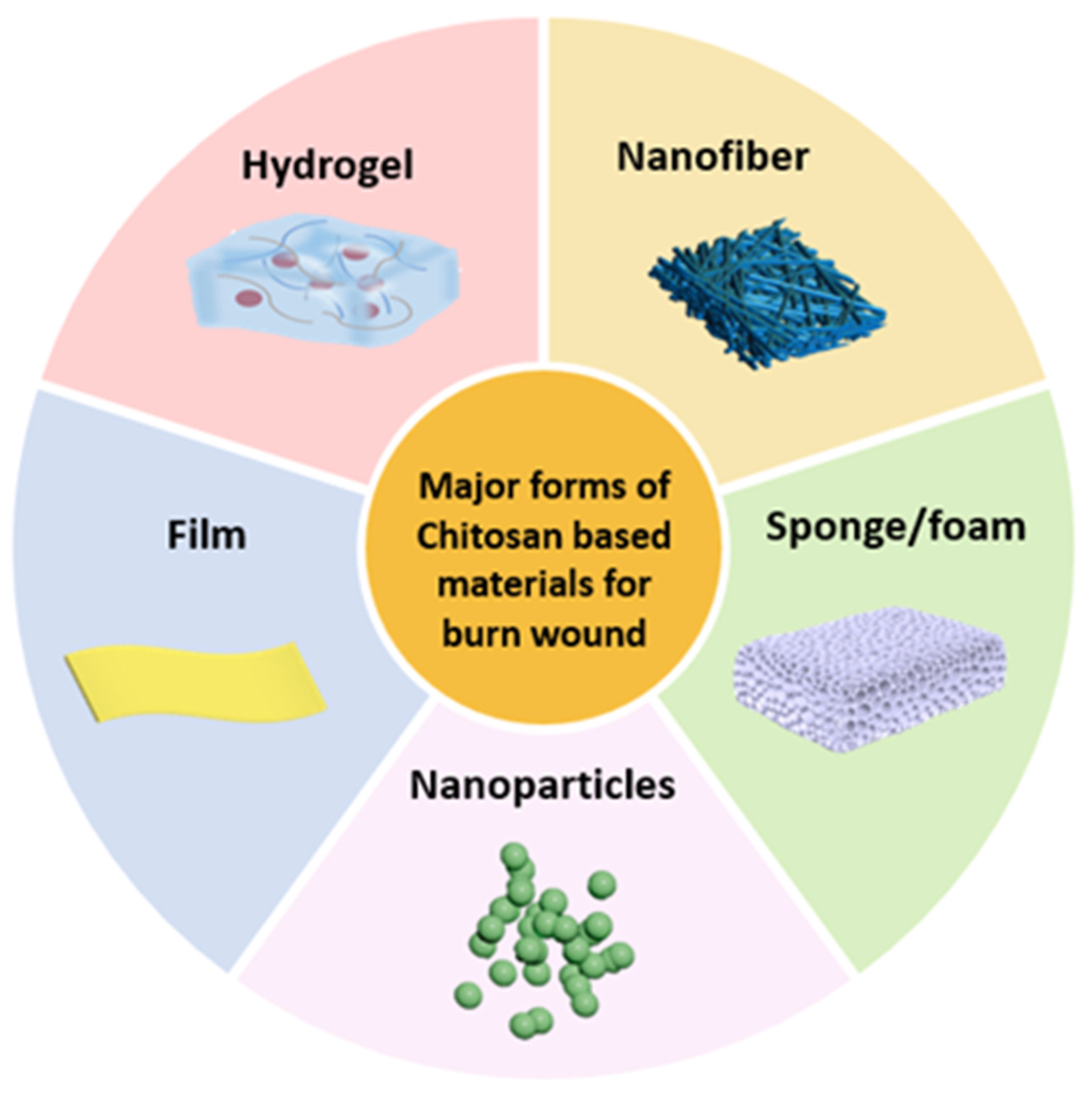
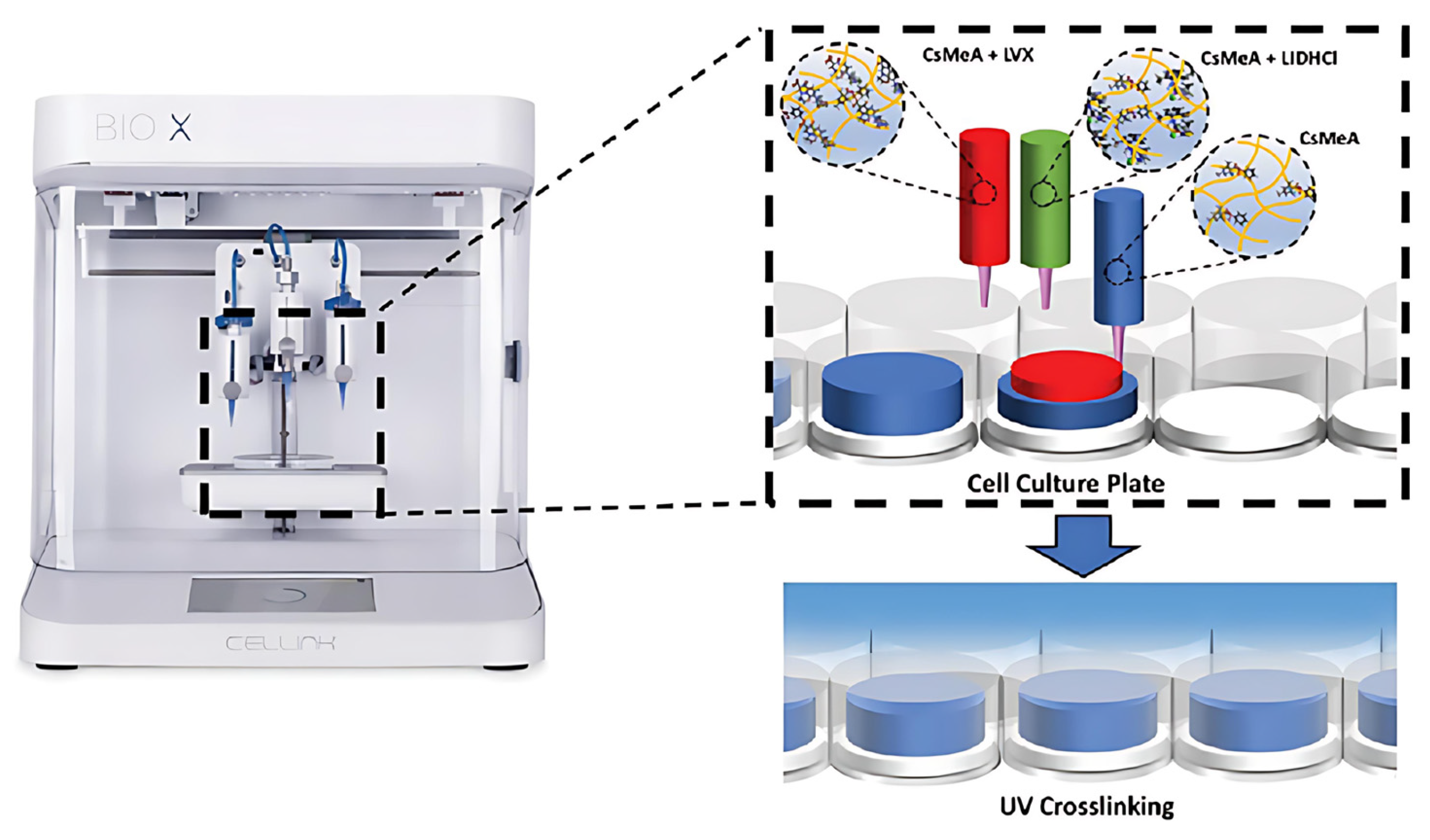
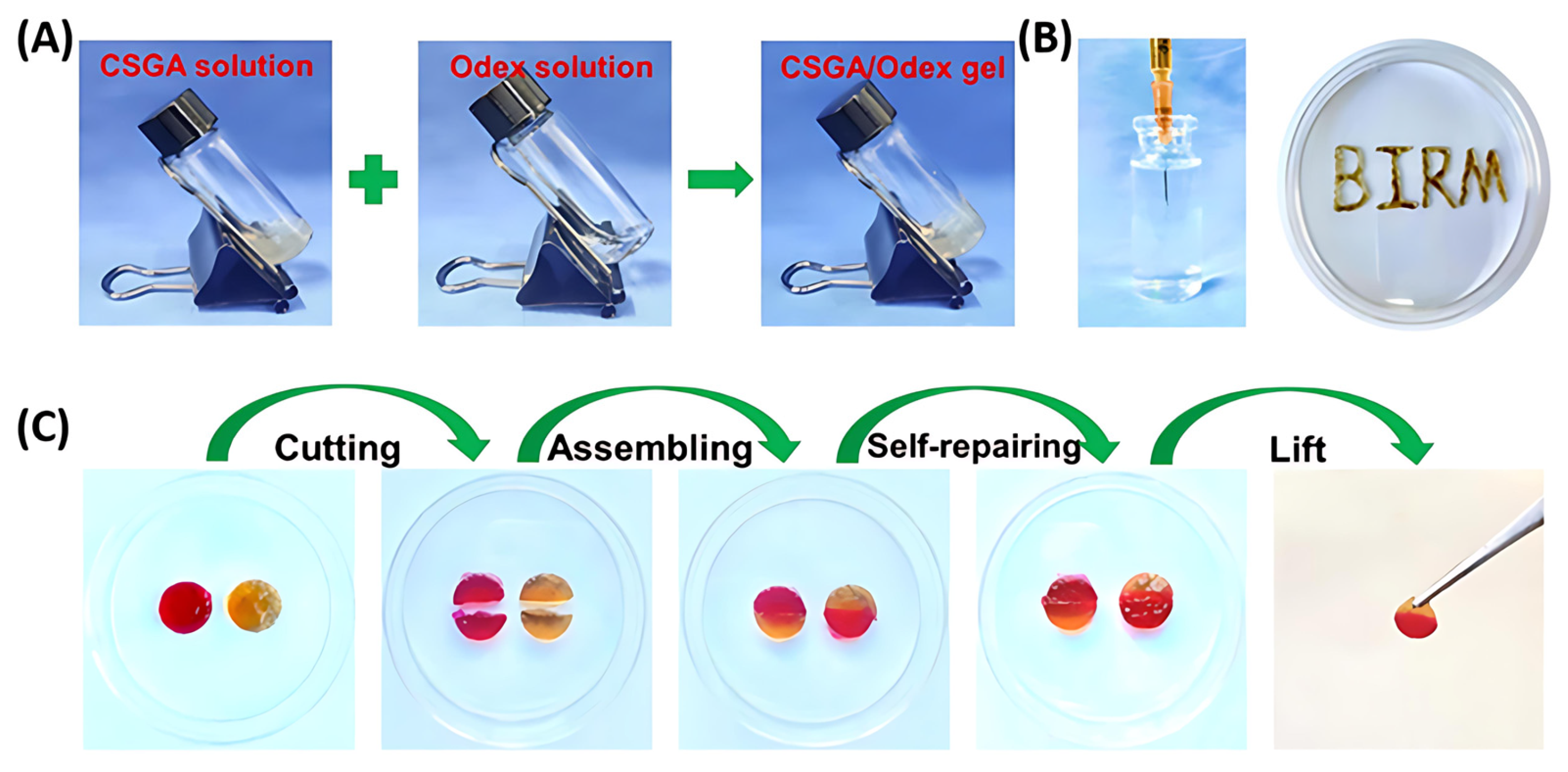

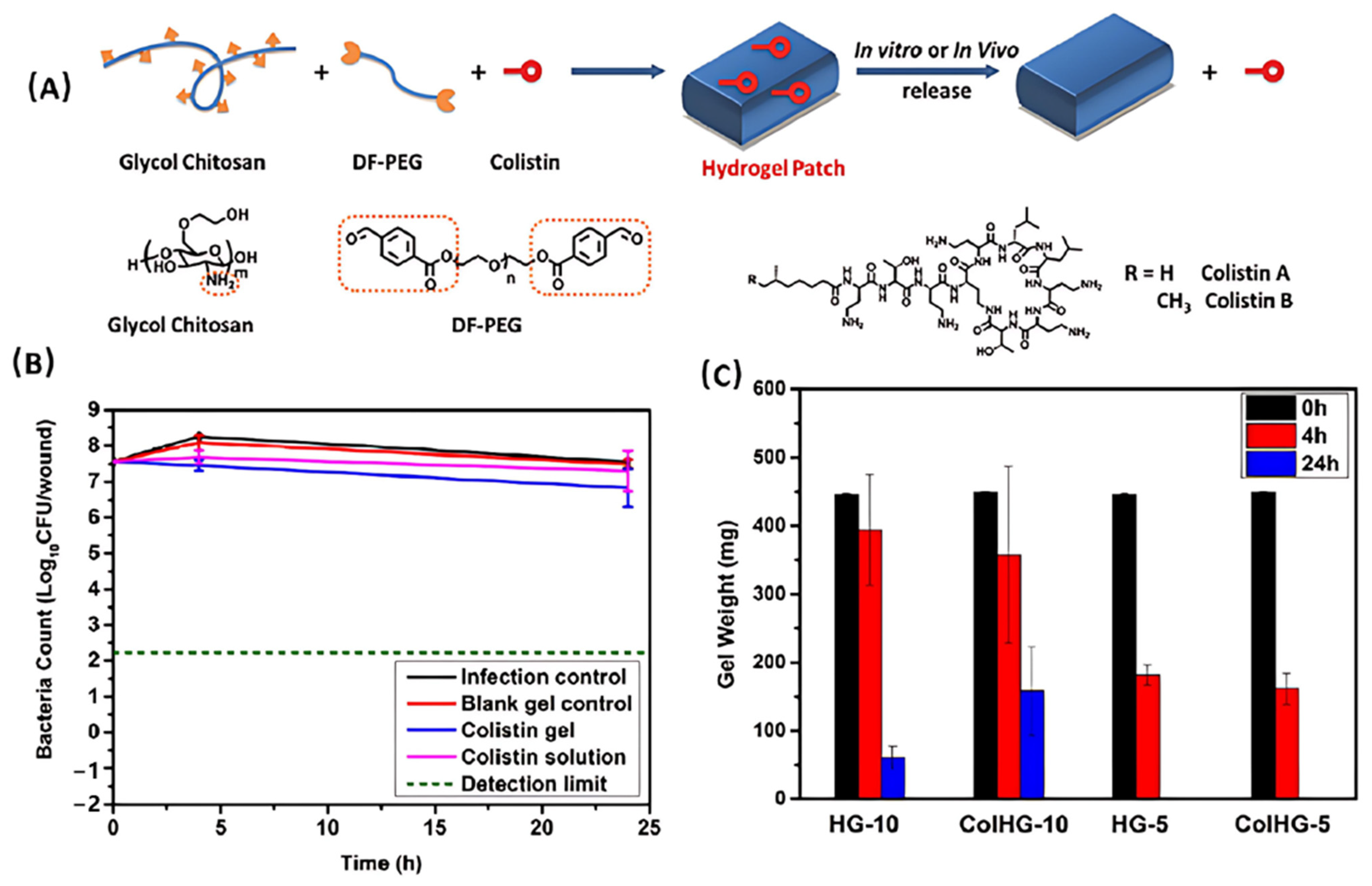



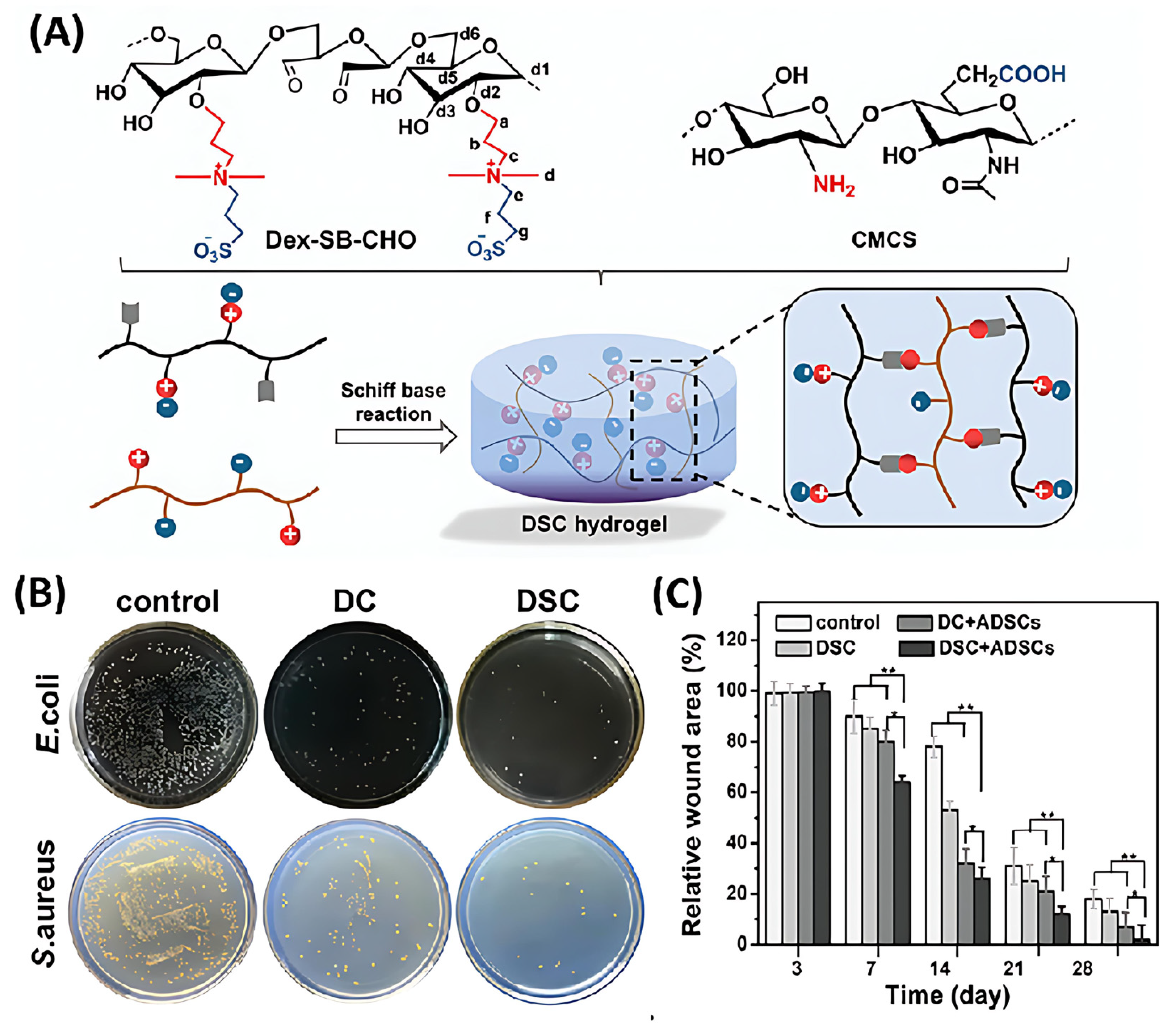
| Chemically Modified Chitosan | Principle of Design | Reagents for Modification | Chemical Formula | Reference |
|---|---|---|---|---|
| Carboxymethyl chitosan | Introduce hydrophilic groups into chitosan | Chloroacetic acid or its sodium salt |  | [39] |
| Quaternary amino chitosan | Quaternizing agents, such as methyl iodide and glycidyl trimethylammonium chloride |  | [40,41] | |
| Acylated chitosan | Disrupt the intramolecular and intermolecular hydrogen bonds of chitosan | Organic acids, acid anhydrides or acyl chlorides |  | [42] |
| Alkylated chitosan | Halogenated hydrocarbons or higher aliphatic aldehydes |  | [43,44,45] |
Disclaimer/Publisher’s Note: The statements, opinions and data contained in all publications are solely those of the individual author(s) and contributor(s) and not of MDPI and/or the editor(s). MDPI and/or the editor(s) disclaim responsibility for any injury to people or property resulting from any ideas, methods, instructions or products referred to in the content. |
© 2025 by the authors. Licensee MDPI, Basel, Switzerland. This article is an open access article distributed under the terms and conditions of the Creative Commons Attribution (CC BY) license (https://creativecommons.org/licenses/by/4.0/).
Share and Cite
Li, S.; Pan, W.; Zhang, M.; Song, K.; Zhou, Z.; Zhao, Q.; Li, G.-Z.; Zhu, C. Chitosan-Based Dressing Materials for Burn Wound Healing. Polymers 2025, 17, 1647. https://doi.org/10.3390/polym17121647
Li S, Pan W, Zhang M, Song K, Zhou Z, Zhao Q, Li G-Z, Zhu C. Chitosan-Based Dressing Materials for Burn Wound Healing. Polymers. 2025; 17(12):1647. https://doi.org/10.3390/polym17121647
Chicago/Turabian StyleLi, Shiyu, Wenlong Pan, Ming Zhang, Kailu Song, Ziqian Zhou, Qilong Zhao, Guang-Zhao Li, and Chongyu Zhu. 2025. "Chitosan-Based Dressing Materials for Burn Wound Healing" Polymers 17, no. 12: 1647. https://doi.org/10.3390/polym17121647
APA StyleLi, S., Pan, W., Zhang, M., Song, K., Zhou, Z., Zhao, Q., Li, G.-Z., & Zhu, C. (2025). Chitosan-Based Dressing Materials for Burn Wound Healing. Polymers, 17(12), 1647. https://doi.org/10.3390/polym17121647









